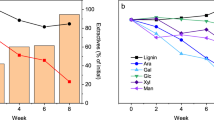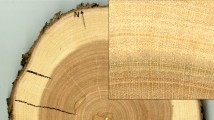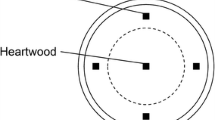Summary
Cerrena unicolor, Ganoderma applanatum, Ischnoderma resinosum and Poria medulla-panis were associated with birch wood that had been selectively delignified in the forest. Preferential lignin degradation was not uniformly distributed throughout the decayed wood. A typical white rot causing a simultaneous removal of all cell wall components was also present. In the delignified wood, 95 to 98% of the lignin was removed as well as substantial amounts of hemicelluloses. Scanning and transmission electron microscopy were used to identify the micromorphological and ultrastructural changes that occurred in the cells during degradation. In delignified areas the compound middle lamella was extensively degraded causing a defibration of cells. The secondary wall, especially the S2 layer, remained relatively unaltered. In simultaneously white-rotted wood all cell wall layers were progressively removed from the lumen toward the middle lamella causing erosion troughs or holes to form. Large voids filled with fungal mycelia resulted from a coalition of degraded areas. Birch wood decayed in laboratory soil-block tests was also intermittently delignified. Selective delignification, sparsely distributed throughout the wood, and a simultaneous rot resulting in the removal of all cell wall components were evident. Scanning electron microscopy appears to be an efficient technique for examining decayed wood for fungi with the capacity to selectively delignify wood.
Similar content being viewed by others
References
American Society for Testing and Materials 1963: Standard method for accelerated laboratory test of natural decay resistance of woods. ASTM D 2017. Philadelphia, Penna
Ander, P.; Eriksson, K.-E. 1977: Selective degradation of wood components by white-rot fungi. Physiol. Plant. 4: 239–248
Anonymous 1952: methods for determining the specific gravity of wood. U.S. For. Prod. Lab. Tech. Notes B-14
Aufsess, H. von; Pechmann, H. von; Graessle, H. 1968: Fluoreszenzmikroskopische Beobachtungen an pilzbefallenem Holz. Holz Roh Werkstoff 26: 50–61
Bar-lev, S. S.; Kirk, T. K. 1981: Effects of molecular oxygen on lignin degradation by Phanerochaete chrysosporium. Biochemical Biophysical Research Communications 99: 373–378
Blanchette, R. A. 1980: Wood decomposition by Phellinus (Fomes) pini: a scanning electron microscopy study. Can. J. Bot. 58: 1496–1503
Blanchette, R. A. 1984: Selective delignification of eastern hemlock by Ganoderma tsugae. Phytopathology 74: 153–160
Blanchette, R. A.; Shaw, G. C. 1978: Associations among bacteria, yeasts, and basidiomycetes during wood deday. Phytopathology 68: 631–637
Cowling, E. B. 1961: Comparative biochemistry of the decay of sweetgum sapwood by whiterot and brown-rot fungi. U.S. Dep. Agric. Tech. Bull. 1258
Effland, M. J. 1977: Modified procedure to determine acid-insoluble lignin in wood and pulp. Tappi 60 (10): 143–144
Eriksson, K.-E. 1981: Fungal degradation of wood components. Pure Appl. Chem. 55: 33–43
Eriksson, K.-E.; Goodell, E. W. 1974: Pleiotropic mutants of the wood-rotting fungus Polyporus adustus lacking cellulase, mannanase and xylanase. Can. J. Microbiol. 20: 371–378
Eriksson, K.-E.; Grunewald, A.; Vallander, L. 1980: Studies of growth conditions in wood for three white-rot fungi and their cellulase-less mutants. Biotechnol. Bioeng. 22: 363–376
Henningsson, B.; Henningsson, M.; Nilsson, T. 1972: Defibration of wood by the use of a white-rot fungus. Royal College of Forestry, Stockholm, Research Notes n:r 78
Kawase, K. 1962: Chemical components of wood decayed under natural conditions and their properties. Hokkaido Daigaku Sapporo J. Fac. Agric. 52: 186–245
Kirk, T. K.; Chang, K.-M. 1981: Potential applications of bioligninolytic systems. Enzyme Microb. Technol. 3: 189–196
Kirk, T. K.; Highley, T. L. 1973: Quantitative changes in structural components of conifer woods during decay by white- and brown-rot fungi. Phytopathology 63: 1338–1342
Kirk, T. K.; Higuchi, T.; Chang, H.-M. 1980: Lignin biodegradation: summary and perspectives. In Kirk, T. K.; Chang, H.-M.; Higuchi, T.; (Eds.) Lignin biodegradation: Microbiology, chemistry, and potential applications, Vol. II. p. 236–243 CRC Press Boca Raton, Fla.
Kirk, T. K.; Moore, W. E. 1972: Removing lignin with white-rot fungi and digestibility of resulting wood. Wood Fiber 4: 72–79
Liese, W. 1970: Ultrastructural aspects of woody tissue disintegration. Ann. Rev. Phytopathol. 8: 231–257
Nakatsubo, F.; Reid, I. D.; Kirk, T. K. 1981: Involvement of singlet oxygen in the fungal degradation of lignin. Biochemical Biophysical Research Communications 102: 484–491
Otjen, L.; Blanchette, R. A. 1982: Patterns of decay caused by Inonotus dryophilus (Aphyllophorales: Hymenochaetaceae), a white-pocket rot fungus of oaks. Can. J. Bot. 60: 2270–2279
Paice, M. G.; Jurasek, L.; Desrochers, M. 1982: Simplified analysis of wood sugars. Tappi 65 (7): 103–106
Peek, R. 1972: Untersuchungen über Befall und Abbau des Fichtenholzes durch Fomes annosus. PhD. Diss. Univ. Hamburg
Ruel, K.; Barnoud, F.; Eriksson, K.-E. 1981: Micromorphological and ultrastructural aspects of spruce wood degradation by wildtype Sporotrichum pulverulentum and its cellulase-less mutant Cel 44. Holzforschung 35: 157–171
Saeman, J. F.; Moore, W. E.; Mitchell, R. L.; Millett, M. A. 1954: Techniques for the determination of pulp constituents by quantitative paper chromatography. Tappi 37 (8): 336–343
Setliff, E. C.; Eudy, W. W. 1980: Screening white-rot fungi for their capacity to delignify wood. In Kirk, T. K.; Chang, H.-M.; Higuchi, T.; (Eds.) Lignin biodegradation: Microbiology, chemistry, and potential applications, Vol. I, pp. 135–149 CRC Press, Boca Raton, Fla.
Spurr, A. R. 1969: A low-viscosity epoxy resin embedding medium for electron microscopy. J. Ultrastruct. Res. 26: 31–43
Wentz, F. E.; Marcy, A. D.; Gray, M. J. 1982: Analysis of wood sugars in pulp and paper industry samples by HPLC. J. Chromatogr. Sci. 20: 349–352
Wilcox, W. W. 1968: Changes in wood microstructure through progressive stages of decay. U.S. Dep. Agric. Res. Pap. FLP-70
Author information
Authors and Affiliations
Additional information
The authors would like to thank Kathy Zuzek for technical assistance and Dr. M. Larsen, Forest Prod. Lab., Madison, for identifying the sporophores of Poria medulla-panis. This research was founded in part by a grant from the USDA Forest Service, Forest Products Laboratory and from the Graduate School, University of Minnesota
Rights and permissions
About this article
Cite this article
Blanchette, R.A., Otjen, L., Effland, M.J. et al. Changes in structural and chemical components of wood delignified by fungi. Wood Sci. Technol. 19, 35–46 (1985). https://doi.org/10.1007/BF00354751
Received:
Issue Date:
DOI: https://doi.org/10.1007/BF00354751




